Abstract
Over the past decades there has been a tendency for the health of schoolchildren to deteriorate. Many factors contribute to this, among them are heavy workloads at school and at home, classes in the system of supplementary education, high level of stress due to exams, an increase in the length of time spent on working with a computer, etc. As a result of this, in particular, there is a decrease in physical and mental performance of schoolchildren. In our study a special set of exercises has been developed and tested that enhance or restore mental performance on the example of the fifth-form pupils. The experimental verification of the complex of kinesiological and breathing exercises has yielded positive results, increasing the mental ability on an average by 14% (up to 25% in some children) within a short time. The results allow us to recommend the proposed complex for the use by teachers and schoolchildren. We have also made recommendations for teachers and parents on the characteristics of the dynamics of mental performance of the fifth-formers, associated with individual peculiarities of their nervous system. They can use these recommendations in the educational process to improve its quality.
Keywords: Healthintellectual labilitymental performanceset of exercisesworkabilitywork pace
Introduction
Article 3 of the Law “On Education in the Russian Federation” states the “humanistic nature of education, the priority of human life and health” (Federal Law, 2020). This means that the state fully implies taking care of the health of its citizens, including children, who spend most of their maturity and personal development in educational institutions. Accordingly, the education system should create necessary conditions for the full physical and mental development of schoolchildren.
At the first Russian assembly “The Health of the peoples of Russia” it was stated that “in all types and kinds of educational institutions, such didactics and such contents of education are implemented that interferes with the spiritual and physical development of a person” (First Russian Assembly, 1992). So, only 10% of school leavers can be considered practically healthy. Many factors contribute to the poor health of schoolchildren, including heavy workloads at school and at home, classes in the system of supplementary education, high levels of stress due to exams, etc.
Problem Statement
Currently, children and adolescents have begun to experience significant overload at school, to walk less in the street, to do less physical education and sports and to spend more time on gadgets, moreover, the use of technology affects the mental health, sleep, physical activity and eating habits of adolescents (Moreno & Hoops, 2020). In this regard, more and more schoolchildren are affected by “chronic fatigue syndrome”, which can manifest itself in nervousness, violation of regime-rules, the decrease of immunity, and, as a result, there is a higher incidence rate, especially the rate of acute respiratory viral infections (Sidorova, 2020).
The creation of a healthy environment and the use of health-saving technologies in the educational process should be one of the conditions for solving this problem (Emanova et al., 2019). Therefore, it is necessary to look for the ways to form an optimal school load, to draw up a rational timetable for educational classes, to dose homework, as well as for the ways to increase and restore physical and mental performance. Thus, the problem of an experimental study of the dynamics of the performance of schoolchildren is relevant.
Research Questions
Human performance is the ability to perform a certain amount of work at a certain time. Mental performance is the amount of mental work associated with the processing of information that must be performed without a decrease in the functions of the body. The basis of workability is existing knowledge, skills, as well as psychophysiological characteristics of a person (Tolochek, 2019).
Various factors affect the performance: physiological and hygienic (the presence or absence of diseases, the quality of food, rest, etc.); physical (illumination, air temperature, noise, etc.); psychological (mood, motivation, etc.). As children grow older, they become more efficient. Due to the improvement of the cardiovascular and respiratory systems, adolescents are capable of twice as productive activity as the first formers (Weiner, 2016).
The researches by Anisimova and Oparina (2015) and others have established that mental performance during educational activity changes appropriately. At first, it rises (a warming-up period), then it reaches a high level (a period of high productivity) with a gradual decrease (a period of reduced workability and the development of fatigue). So, workability of the last lessons can be half lower than that of the first lessons. In the period of reduced workability, three zones are distinguished: incomplete compensation, end spurt and growing fatigue. Moreover, in the zone of growing fatigue, it is impossible to require performing intensive loads, since the exhaustion of the body energy potentials begins (Anisimova & Oparina, 2015). For the optimal scheduling of classes, Mathematics, Russian, Computer science, Physics and Chemistry should be planned for 2-3 lessons of a school day, and creative lessons and physical education should be held last. Daily and weekly rhythms of vital activity also affect workability. At the beginning and at the end of the working week, workability is lower than in the middle of the week. Accordingly, the greatest workability is characteristic of “Tuesday and Wednesday - the days of the highest performance of mental work.” Therefore, in scheduling, the set of the most difficult lessons should take place on Tuesday and Wednesday (Chernitsyna, 2014).
A major role in learning is played by the emotional state of a person. Positive emotions stimulate performance. “Emotions in education are one of the most exciting and relevant studies” (Schuts & Pekrun, 2007). According to American physiologist and psychologist D. Dearborn, in the process of laughter, there is a “brain massage”. Professor E. K. Sepp attaches significant psychophysical importance to laughter in human life because “laughter has a refreshing effect on a tired, stressed-out brain” (as cited in Kaschenko, 2019).
An unconditional factor of the workability is the motor regime, which can be achieved with the help of physical education lessons, breaks for physical exercises, active games and dancing. Daily activity is also affected by the duration of night sleep and a balanced diet (Minina, 2000).
In the learning process, the activity of students depends on their individual characteristics, such as temperament. According to R. I. Michinskay and D. A. Farber, a neuropsychological examination has revealed a sharp increase in the number of children, aged from 9 to 13 years of age, showing signs of increased fatiguability and reduced workability. In children at the age of 10-11, the risks of school maladaptation associated with variations in attention and rapid fatigue during classes increase. It has been stated that children with a high speed of nervous processes have a high rate of muscle response, a faster understanding of the studied material and a faster forgetting of the educational material than slow children (as cited inMakarova & Paranicheva, 2017).
As the teaching practice shows, the attitude to educational activities is an important factor. So, for students who regularly prepare for classes, forgetting is going on slowly and gradually. For those students who want to remember a large amount of material in a short time before the exam, forgetting happens rapidly and dramatically (Ryzhov, 2015).
In addition, the form of training (current lessons, extracurricular activities, exams, etc.) affects the dynamics of workability, at the same time emotional stress plays an important role. According to Minina (2009), an examination period is always characterized by the development of high emotional strain. By changing the values of heart rate, systolic and diastolic blood pressure in the conditions of a real pre-examination state, it has been found out that an increase in these indicators is a result of the generalized reaction of the organism of students and schoolchildren to examination stress.
Purpose of the Study
The purpose of the experimental work has been to study the dynamics of mental performance of the fifth formers and determine how to increase it. The goal of the study is the process of teaching schoolchildren, and the subject is mental performance of the fifth formers in the learning process.
The objectives of the study are the analysis of the literature on the research problem; the choice of methods; the study of the dynamics of mental performance of the fifth formers in different periods of training; a selection, experimental verification and a determination of the effectiveness of a set of exercises that contribute to mental performance of the fifth formers.
The hypothesis of the study is as follows: mental performance of the fifth formers decreases as they become tired, that is, at the end of the school day, at the end of the school week. The use of a set of special exercises will promote the increase or restoration of mental performance.
The practical significance of the experimental work consists of testing a set of exercises to increase the level of mental performance of the fifth formers in the learning process. The set can be recommended to be used by teachers at the lessons, as well as by children and their parents to increase the effectiveness of training and work activities.
Research Methods
The following works have been used as methodological approaches: activity theory (L. S. Vygotskiy, P. Ya. Halperin, etc.); methodology of psychological and pedagogical research (Yu. K. Babanskiy, V. I. Zagvyazinskiy and others); valeological concept (I. I. Brekhman, L. G. Tatarnikova, M. G. Kolesnikova, etc.); research results in the field of human physiology and hygiene (M. V. Antropova, A. G. Khripkova and others).
The following methods have been used in the study: the analysis of literary sources; observation; the diagnostic technique of mental performance determination (tapping-test by E. N. Ilyin); experiment; the methods of mathematical data processing.
We have conducted a study of mental performance of the fifth formers. Also, we have selected and tested the ways to increase mental performance. The study has been carried out on the basis of the Municipal budgetary educational institution “Gymnasium No. 27” of Kurgan. The experiment has involved 32 students of the 5 form “B” (11 - 12 years old).
The choice of subjects is associated with the characteristics of learning at this age. The fifth form is one of the most difficult periods in training, as schoolchildren need to adapt to a large number of new school subjects and new teachers, each has his/her own requirements. New educational material, which is complex and voluminous, makes it worse. Therefore, the search for the ways to facilitate educational activities by the increase of workability is especially relevant for the fifth formers.
In our study, we have used the method of express diagnostics of the properties of the nervous system according to the psychomotor indicators by Iliyn (2003) (tapping-test) due to its simplicity for the fifth-formers and its low time costs. The technique involves determining the dynamics of the maximum rate of hand movement, depending on the strength of the nervous system. The strength of the nervous processes is an indicator of the performance of the nervous system. The greater its strength is, the greater load it can withstand. The tapping-test is in tapping on a sheet of paper with a pencil at maximum speed for a specific time (10, 30 seconds).
In the course of the study, we have determined the indicators of the level of mental performance in the dynamics: of a school day, a school week, as well as after doing a set of exercises, the indicators of the work speed (according to the 10-second tapping-test), intellectual lability (on an average value of the 5-second tapping-test), the type of dynamics of the maximum rate of movements (according to the 30-second tapping-test).
Based on the analysis of psychological and pedagogical literature, we have made up a set of kinesiological exercises that are aimed at restoring the interaction between the right and left hemispheres, and then between other parts of the brain. They are used to improve the processes of attention, memorization, to intensify the clarity of thinking, to help to solve problem tasks (Badeeva, 2018). To enhance the effect of kinesiological exercises (“Ear - nose - cotton”, “Fist - rib - palm”, “Lezghinka”, “Thumb rotation”) we have included several exercises from the breathing gymnastics by A. N. Strelnikova (“Ladoshki (hands)”), “Put arms around the shoulders”, “Cat”, “Pump”) (as cited in Schetinin, 2018), as well as the visual gymnastics (eye movements up and down, left and right, rotation). The breathing gymnastics by A. N. Strelnikova is a unique method of healing the whole body. In connection with the improvement of blood supply to all systems and organs, it also helps to increase mental performance. The time of the completion of the whole set of exercises is 5 minutes.
Findings
In the course of the experimental work, the following results have been obtained. By the end of the school day, the number of the fifth-formers with a high level of workability decreased by 19%; with a mid-level - decreased by 16%; and with a low level - increased by 35% (figure
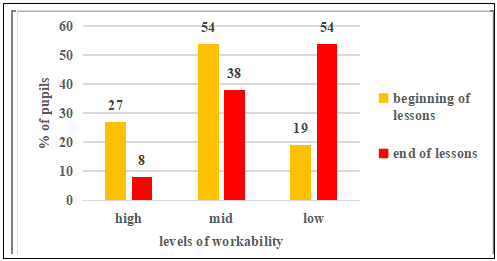
At the same time, a decrease in workability occurred in the range from 0% to 26%. On average, workability during the school day decreased by 12%. Thus, we can conclude that it is necessary to take into account the fact of a decrease in the schoolchildren’s workability at the end of the school day and not to schedule these difficult subjects, being 5 and 6 in a row.
By the end of the school week, the number of the fifth formers with a high level of working capacity decreased by 12%; with a mid-level decreased by 19%; and with a low level of workability - increased by 31% (figure
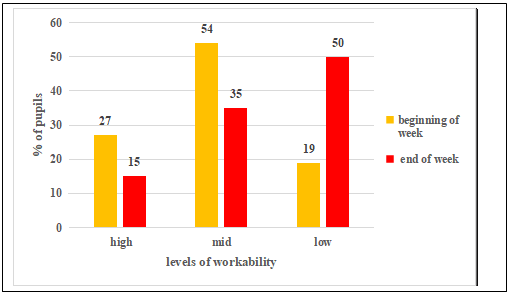
At the same time, a decrease in workability during the week occurred in the range from 0% to 30%. This indicates that by the end of the week a fatigue and a decrease in workability accumulate. Taking this fact into account, it is necessary not to overload pupils with difficult subjects on Friday (for a five-day week) and to put no more than 4-5 lessons on the schedule during this day in the 5th form.
Analyzing the average indicators of the performance of the five-second tapping-test, we have found out that 35% of fifth-formers worked at a fast rate, 38% worked at an average normal rate and 27% did it at a slow rate (figure
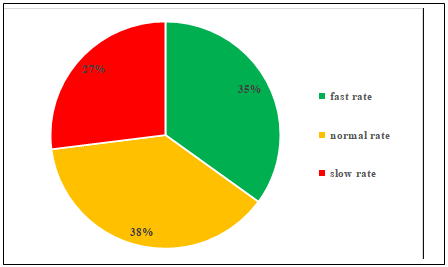
It follows that 27% of pupils tend to perform all the tasks at a slow rate, and this rate is normal for them. Making them work faster is not recommended, as you can affect the psyche negatively and create a stressful situation.
According to the level of intellectual lability, the fifth-formers have been distributed as follows: 31% had a high level; 58% had a mid-level; 11% had a low level (figure
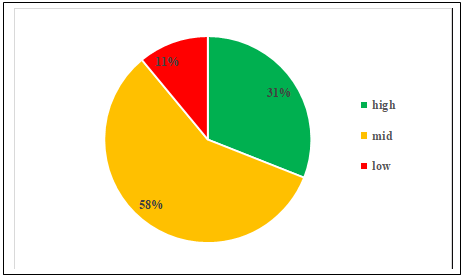
Intellectual lability characterizes the ability to shift the focus quickly, to be able to solve problems as much as possible and as well as possible in a short time. A high level of intellectual lability indicates a high rate of excitation processes that provide an instant response to a task, allow solving the task quickly and accurately, and immediately shift to other tasks. Accordingly, it is necessary for teachers to familiarize themselves with these data so that they can consider the ability of some children to work at a slow rate and perform only specific tasks. In this case, they will learn the material better and have good academic performance.
After doing the set of exercises, the indicators of mental performance of fifth formers improved significantly. So, the number of students with a high level of mental performance increased by 35%, with a mid-level increased by 3%, and with a low level decreased by 38% (figure
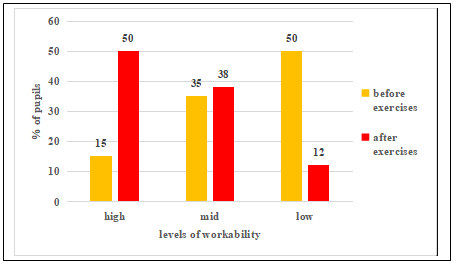
On average, after doing the set of exercises workability increased by 14%. At the same time, an increase or restoration of workability after doing a set of exercises occurred in the range from 0% to 25%. This indicates the effectiveness of the use of this set of exercises to increase or restore the mental performance of pupils in a short time. In this regard, it is necessary to familiarize the pupils themselves and teachers with a set of exercises and recommend its use in full or in the form of separate exercises before tests, before exams, before the last lessons, before doing homework in order to increase mental performance.
According to the types of dynamics of the maximum rate of movements, pupils have been distributed as follows: the dynamics of a convex type was observed in 4% of pupils (the rate first increased, and then decreased below the initial level), which corresponds to a strong type of nervous activity. The dynamics of an even type was shown by 23% of the fifth formers (the rate remained at approximately the same level throughout the work period), which corresponds to a balanced (medium or stable) type of nervous activity; the dynamics of an intermediate type - 23% of people (the rate of work gradually decreased) and a concave type - 15% (at first, the rate decreased, then temporarily increased to the initial level). Intermediate and concave types of dynamics correspond to a medium-weak type of nervous activity. In general, 38% of schoolchildren belonged to the medium-weak type. The dynamics of the descending type was detected in 35% of students (the rate quickly decreased and remained at a low level), which corresponds to a weak type of nervous activity (figure
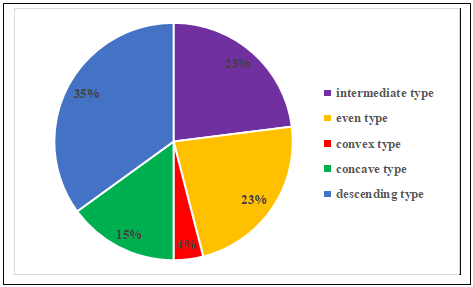
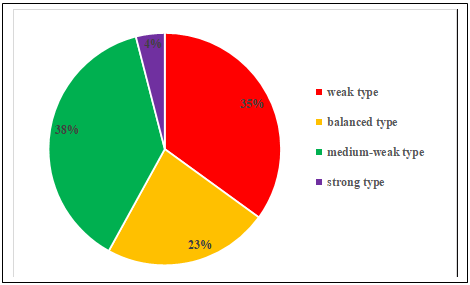
Thus, the children with a weak type of nervous activity need to carry out most of the work at the beginning of the activity, leaving the easiest work or activities of interest by the end. For schoolchildren with a strong type of nervous activity, the most difficult tasks may be done best after a warming-up period, that is, in the second third of the activity. And for students with balanced (medium) and medium-weak nervous activity, it is possible to give a uniform load throughout the entire period of activity and reduce it by the end of the work, especially for the medium-weak type.
Conclusion
In modern conditions there is a decrease in the health indicators of schoolchildren due to excessive school workload, lengthy work at the computer and other reasons. All this leads to overfatigue and to a decrease in pupils’ physical and mental performance and as a result, to a decrease in the quality of education. In this regard, the urgent is the problem of finding ways to improve the health of children. In the course of the experimental work, we proposed a way to increase mental performance - a set of special exercises.
As a result of the experimental work, we determined various characteristics of mental performance. In general, the research hypothesis has been verified, namely: mental performance of the fifth formers decreases as they become tired, that is, at the end of the school day, at the end of the school week. The effectiveness of the proposed set of exercises has been proved, its use has allowed increasing mental performance of the fifth formers, on average, by 14%.
The study has a practical significance, which consists in the possibility of using the set of exercises we have chosen to increase the mental performance of fifth formers both in the classroom and at home while doing homework. Also, we have made recommendations for teachers on the individual characteristics of students in the examined class, connected with their level of mental performance, optimal work rate, intellectual lability, and the strength of the nervous processes. These recommendations will allow teachers to realize the didactic principle of accounting for individual psycho-physiological characteristics of students more successfully.
References
- Anisimova, N. V., & Oparina, О. N. (2015). Distribution of study load of gymnasium pupils in the dynamics of the working day and week on the basis of parameters of mental performance. Journal of Higher Educational Institutions. Povolzhskiy Region. Humanitarian Sciences, 4(36), 226-234.
- Badeeva, A. V. (2018). Non-traditional gymnastics in the system of healing children of preschool age. In Health-Saving Technologies in the Practice of Preschool Education. Collection of Scientific and Methodological Works. Armavir.
- Chernitsyna, N. V. (2014). Dynamics of psychophysiological indicators of workability and fatigue of pupils of junior forms during working week. Journal of Yugorsk State University, 1(32), 43-47.
- Emanova, S., Ryleeva, A., Zakharova, E., & Bernikova, S. (2019). Role of healthy environment in preserving and strengthening students’ well-being in institutions of secondary and additional education. Advances in Social Science, Education and Humanities Research, 392, 323-326. https://doi.org/10.2991/assehr.k.200113.067
- Federal Law “Of education in the Russian Federation” N 273. (2020, March 1). http://www.consultant.ru/document/cons_doc_LAW_140174
- First Russian Assembly “Human health”, Nizhny Novgorod, May 15-18, 1991: Abbr. Stenographic. (1992). Russian Fund “Human health”.
- Iliyn, Е. P. (2003). Psychomotor Organization of a Person. Peter.
- Kaschenko, V. P. (2019). Pedagogical Correction. Correction of Drawbacks of the Character of Children and Adolescents (p. 231). Publishing house Youright. https://urait.ru/bcode/444786
- Makarova, L. V., & Paranicheva, Т. М. (2017). Rational organization of learning process for pupils of the general school (5-9 forms). Methodical Manual for Teachers. Moscow. http://www.ivfrao.ru/edu_support/library/files/Makarova2017.pdf
- Minina, E. M. (2000). The content of valeological activity in the gymnasium. In Collection of Scientific Works of Graduate Students and Applicants Kurgan State University (pp. 118-121). Kurgan.
- Minina, S. М. (2009). Adaptation of the blood circulatory system to examination loads. Collection of Scientific Works of Postgraduate Students of Kurgan State University, XI, 7-8.
- Moreno, M., & Hoops, A. (2020). Inside and Outside Schools (p. 426). Academic press. https://www.elsevier.com/books/technology-and-adolescent-health/moreno/978-0-12-817319-0
- Ryzhov, V. N. (2015). Dydactics: Training Manual for Students of Pedagogical Colleges and Lyceums (p. 319) [Electronic source]. UNITY-DANA. https://rucont.ru/efd/352854
- Schetinin, М. N. (2018). Respiratory gymnastics by Strelnikova. Moscow.
- Schuts, P., & Pekrun, R. (2007). Emotions in education. Academic press. https://www.elsevier.com/books/emotion-in-education/schutz/978-0-12-372545-5
- Sidorova, E. O. (2020). Assessment of mental performance of primary schoolchildren. In Actual Problems of the Professional Sphere in the Modern World. Materials of the VII International Scientific and Practical Conference of Young Scientists in Foreign Languages (pp. 32-34). Yekaterinburg.
- Tolochek, V. (2019). Mental performance dynamics: part II. Psychological features of 2-year and 4-year cycles. Psychological Journal, 40(6), 31-43. https;//doi.org/10.31857/S020595920006076-9
- Weiner, E. N. (2016). Valueology. Flint.
Copyright information

This work is licensed under a Creative Commons Attribution-NonCommercial-NoDerivatives 4.0 International License.
About this article
Publication Date
28 December 2020
Article Doi
eBook ISBN
978-1-80296-098-3
Publisher
European Publisher
Volume
99
Print ISBN (optional)
-
Edition Number
1st Edition
Pages
1-1040
Subjects
Multicultural context, learning environment, modern society, personality formation, informatization of the society, economics and law system of the region
Cite this article as:
Zakharova, E., Bernikova, S., & Ryleeva, A. (2020). Dynamics Of Mental Performance Of Fifth-Form Pupils And Ways To Improve It. In N. L. Shamne, S. Cindori, E. Y. Malushko, O. Larouk, & V. G. Lizunkov (Eds.), Individual and Society in the Modern Geopolitical Environment, vol 99. European Proceedings of Social and Behavioural Sciences (pp. 1001-1011). European Publisher. https://doi.org/10.15405/epsbs.2020.12.04.115

